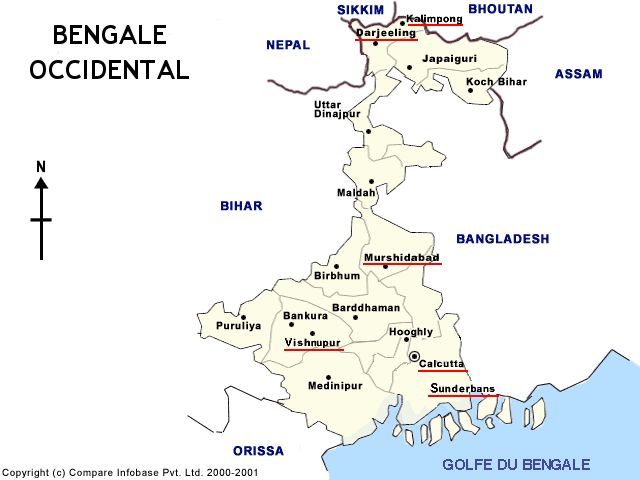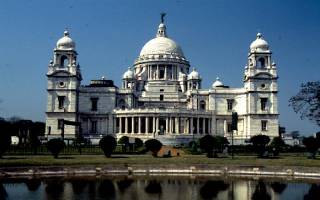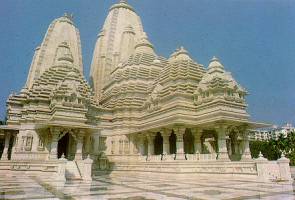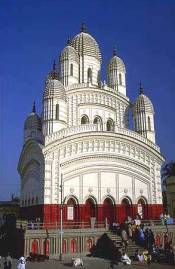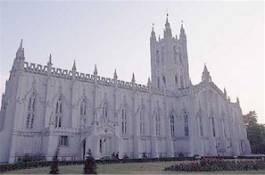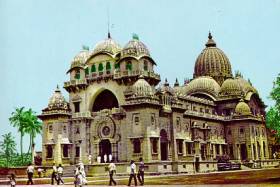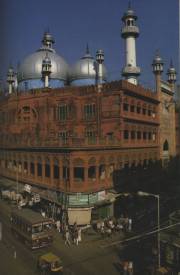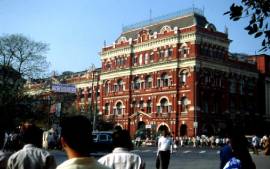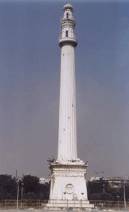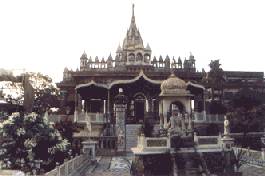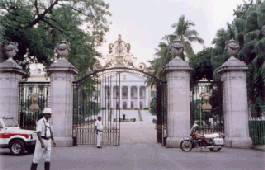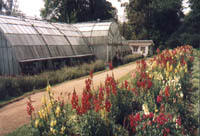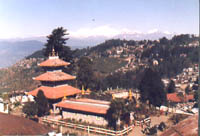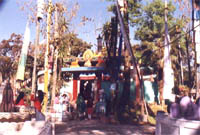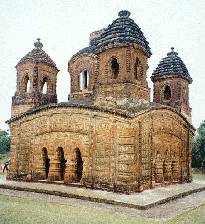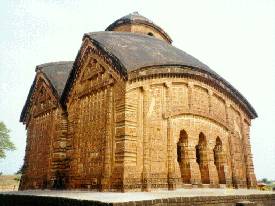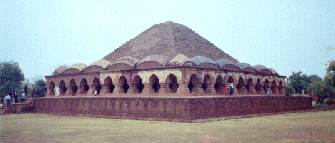West Bengal lies in the east of India. It has 75 million inhabitants for an area of 87853 km2. The capital of the state is Calcutta. It speaks Bengali. The north of Bengal is dominated by the Himalayas while the south is made up of fertile plains. The Ganges and the Brahmaputra form a gigantic delta before throwing themselves into the Gulf of Bengal. The state is one of the most watered in the country (between 200 and 800 mm of water during the monsoon months.)
West Bengal is still considered the cultural heart of India. Many intellectuals and artists were born there (the poet Rabendranath Tagore, the film-maker Satyajit Ray). The state is the main producer of jute. It is famous for its tigers, its tea plantations of Darjeeling, its silk saris.
History
The history of Bengal predates the arrival of the Aryans in India. The Mahabharata mentions some of his kings. Bengal is then known as "Gauda" or "Vanga". Integrated successively into the Maurya and Gupta empires, Bengal also had its own dynasty of independent rulers, the Pala, who expanded the territory to encompass the current Bihar, Orissa and Bangladesh. Bengal then passed under the control of the Sultans of Delhi, then of the Mughals, then of the nabobs of Bengal.
In the 17th century the first European settlers settled in the region. The English succeeded in establishing themselves better than the others and in the middle of the eighteenth century they took effective control of Bengal. Calcutta became the capital of the British Raj. At the time Bengal included the present Bangladesh, Bihar, Orissa and extended as far as Agra. Political decisions were often fragmented, notably in 1905. But the protests were such that the score was canceled. In 1911, frightened by increasingly violent nationalist protests, the English moved their capital from Calcutta to Delhi. Victim of a severe famine in 1943 and of communal clashes in 1946, Bengal was split in two to independence in 1947. The west became West Bengal under Hindu rule, the east becoming East Pakistan under Muslim rule . The latter will become Bangladesh in 1971.
Map of the province of West Bengale
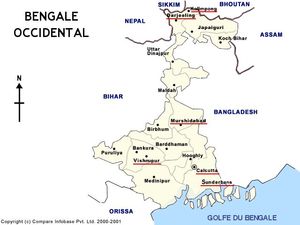
Map of West Bengale
Calcutta
Crossed by the Hooghly River, Calcutta is the capital of West Bengal. It has 12 million inhabitants making it the second largest city in the country behind Mumbai (Bombay). Officially the name of Calcutta is Kolkata since a government decision taken on August 24, 1999. But this change is far from entering all minds, including in India.
The history of Calcutta, in terms of Indian history, is fairly recent, since the city has existed as such only since 1690. On that date, on August 24, exactly, Job Charnock, an official of the British East India Company, was given permission to build a factory in Sutanati. In 1698 the Company obtained the right to collect property taxes on the cities of Sutanati, Kalikata and Govindapur. On this occasion the three cities are united in a single baptized Calcutta. In 1717, taking advantage of the weakening of the Mughal empire, the Company obtained trade rights in Bengal. In 1735 the population is 100,000 inhabitants.
Little by little, the nabob of Bengal affirms its independence from the Mughal power. On 20 June 1756 the new nabob, Siraj, attacked Calcutta and seized Fort William. Many Englishmen will die in one of the fort's rooms. The episode will mark the spirits and will become famous under the name of "night of the black hole". The company calls on Robert Clive, who then runs Madras. On 2 January 1757 he took over Calcutta alongside Admiral Watson and on 23 June he beat the troops of Siraj at the Battle of Plassey. From there, the influence of Calcutta will continue to grow. In 1764 Mir Kasim, the nabob of Bengal, allied himself with the Mughal emperor Shah Alam and with the nabob of Oudh to attack the English. But they defeat the Nabob's troops at the Battle of Buxar. On August 12, 1765, she signed a treaty by which England obtained the collection of taxes in Bengal, Orissa and Bihar.
Calcutta became the capital of the British Empire in India. In 1772 Warren Hastings was appointed Governor of Bengal and then Governor General the following year. The population is then 200,000. The governors succeeded one another, extending a little more the English domination over India.
Bengal also becomes the focus of the dispute for independence. Numerous reform movements were born in Calcutta under the impulse of the Bengali intellectuals. After many troubles and the bitter failure of the partition of Bengal, the British decided in 1912 to transfer the capital from Calcutta to Delhi. This transfer did not prevent Calcutta from continuing to grow, both economically and demographically. The city suffered enormously during independence as its population was composed of Hindus and Muslims. It still suffered in 1971 when the creation of Bangladesh because it saw the influx of thousands of Pakistani refugees. It was at this time that Mother Theresa made known the problems of Calcutta to the whole world.
Today the city is still overcrowded and presents visitors with a face often despairing. Calcutta is still nevertheless the cultural capital of India and offers an undeniable and astonishing charm. It is equipped with a subway.
The fort William
The present fort was built in 1781 on the foundations of the former assumed in 1756 by Siraj, the nabob of Bengal. The new fort could house 10,000 soldiers and was considered impregnable. It has an irregular octagon shape pierced with seven doors. The vast space which surrounds the fort, the Maidan, is traversed by canals intended to flood a part in case of attack. It is necessary to believe that the reputation of the fort is founded since since its construction no cannon shot was fired.
The fort is always occupied by the military and its visits are only made with permission.
The Victoria Memorial
This large marble building, combining British architecture and Mughal architecture, is one of the most impressive vestiges of the British presence in Calcutta. Its construction began in 1906 at the instigation of the Vice-King, Lord Curzon, in memory of Queen Victoria. It was inaugurated only on December 21, 1921.
The statue of a bronze angel is placed on top of the dome with a height of 61 meters. The lobby is 50 meters high. It is overlooked by a balcony where you can see murals depicting the life of Victoria.
The other rooms contain many articles belonging to the queen, including her pink wooden piano, desk, letters and manuscripts. One can also see the black marble throne of the nabob Siraj defeated by clive in 1757 and a painting of 6m by 3m depicting King Edward VII in Jaipur.
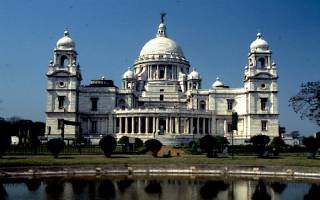
The Victoria Memorial
The temple Birla
This temple, 49 meters high, is recent, opening in 1996 after 26 years of construction. The exterior of the temple is in sandstone while the interior is in marble. Sculptors from all over India participated in its construction, particularly for the delicate cutting of walls and roofs. Extracts from the Baghavad Gita were engraved on the marble.
The temple houses the representations of Radha, Krishna, Shiva and Durga.
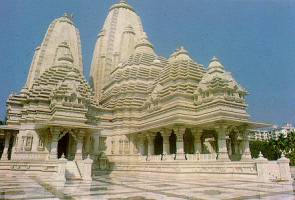
The temple Birla
The temple of Dakshineswar Kali
Built in 1855 by the Rani Rashmoni, this is where the wise Ramakrishna would have attained enlightenment. The place where he lived in the temple is always visible and open to visitors. The temple is dedicated to the goddess Kali whose statue is on a lotus flower in silver. The main temple is surrounded by 12 small temples dedicated to Shiva.
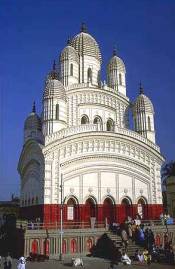
The temple of Dakshineswar Kali
The temple of Kali (Kaligath)
Built in 1809 on the banks of the river, the temple of Kali is an important center of pilgrimage. The place is indeed sacred because according to legend, a piece of the body of the goddess would have fallen at this place (Kalighat) when it was cut by Vishnu. The statue of the goddess is in black stone and decorated with gold and silver. Goats are always sacrificed for its cult and every year the statue is bathed during the snanyatra.
St Paul's Cathedral
The first stone of the cathedral was laid by Bishop Wilson in 1839 and it was inaugurated in 1847. It was the first "Episcopal Church" of the Orient. It is 82 meters long and 27 meters wide. The original tower, 61 meters high, was first destroyed in 1897 after an earthquake and then again in 1934 after a new earthquake. It was rebuilt in 1938 on the model of the Bell Harry Tower of the Canterbury Cathedral.
Inside you can see magnificent stained glass windows and beautiful wooden carved benches. The east wall is covered with two splendid Florentine frescoes. The tomb of Bishop Wilson is in a small room in the basement of the cathedral.
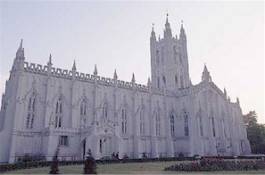
St Paul's Cathedral
The Belur Math
The Belur Math is the seat of the Ramakrishna Order. It was built in 1938 in memory of Sri Ramakrishna who preached the unity of religions in the nineteenth century. The development of Math was mainly the work of Swami Vivekananda. The ashes of the two men were placed there. The building is the mixture of a mosque, a temple and a church.
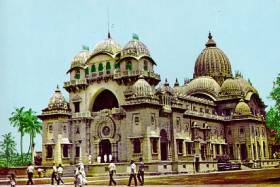
The Belur Math
The Nakhoda mosque
This mosque, the largest in Calcutta, was built between 1926 and 1942 on the model of the mausoleum of the Mughal Emperor Akbar near Agra. The front door of the mosque is an imitation of the Buland Darwaza of the Jama Masjid of Fatehpur Sikri. It has a large dome and minarets of red sandstone of 46m high. It can accommodate up to 10,000 faithful.
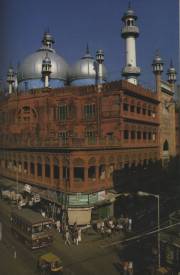
The Nakhoda mosque
The writer's building
This building was built in 1780 to house the attorneys and clerks of the Indian Company. It then housed the Fort William College and then became an administrative headquarters. Today it is the seat of the Secretariat of State. Its Corinthian-style façade was not added until 1889. Statues adorn the parapet of the roof.
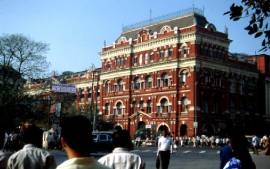
The writer's building
The Howrah's bridge
Officially named Rabindra Setu, the Howrah Bridge was built in 1943 to facilitate military transportation between Calcutta and the neighboring city of Howrah. Today it is the main gateway to Calcutta. The bridge measures 450 meters long on a single arch and is an engineering wonder. It can lengthen by more than one meter during the hot summer heat. More than 50,000 vehicles and 2 million people pass through each day.
Do not forget that in India bridges are considered strategic military locations and it is strictly forbidden to take pictures of them.
The Shahid Minar
Originally named Ochterlony Monument by the English, this 48 meter high column was erected in 1828 to commemorate the English victory in the Nepali War of 1814. The style is a mixture of Syrian, Egyptian and Turkish architecture. In 1968 it was renamed Shahid Minar (Column of the Martyrs) in memory of Indian independence fighters. Visitors can climb the 218 steps leading up to the summit but only after obtaining an authorization issued by the police.
The square surrounding the column is a common gathering place for demonstrations or political rallies.
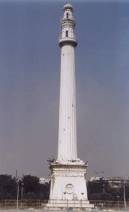
The Shahid Minar
The temple of Pareshnath
It is a Jain temple built in 1867 and dedicated to Shitalnatha, the tenth Tirthankara. An oil lamp burns continuously. The temple is surrounded by an arboretum decorated with numerous Jainas effigies. Three other temples are nearby, one of which is dedicated to Mahavira, the 24th Tirthankara.
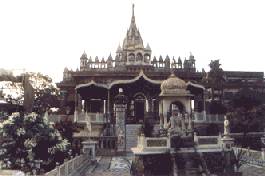
The temple of Pareshnath
The Raj Bhavan
This palace was built between 1797 and 1803 to serve as a residence for the Governor General. The Bhavan has six gates surmounted by a lion, symbol of the British Empire. A collection of antiques is found inside, including the throne of Tipu Sultan. A beautiful garden surrounds the building. Today the Raj Bhavan houses the residence of the Governor of Bengal.
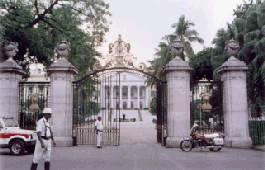
The Raj Bhavan
Darjeeling
Darjeeling is a large village located at 2,134 meters above sea level, and is synonymous with tea all over the world. Its mountainous climate allows to escape the high heat and the humidity of the plain.
It was the English who made it a climatic station for their soldiers and an advanced post because of its proximity to Nepal and Tibet. At the time they settled in Darjeeling in the early 19th century, the region belonged to the Gurkha who had taken it to the Sikkim raja. The city then developed rapidly thanks to Nepalese immigration. Today still the majority of the population speak Nepali and the region has enjoyed administrative autonomy for about fifteen years.
You can reach Darjeeling by a small train that winds its way through the mountainside. Treks are organized to climb a little further up the hills and offer beautiful views of the Himalayas, especially on the Kanchenjunga, the highest peak in India at an altitude of 8598 meters. The visits organized in the tea plantations will allow you to see the manufacture.
The Tiger Hill
The Tiger Hill is 11 km from Darjeeling and owes its fame to its incredible panorama of the Himalayan range. One can see some of the highest peaks in the world: Everest (8848 m), Lhotse (8501 m), Kanchenjunga (8598 m) and Makalu (8475 m). Departure to Tiger Hill is usually in the wee hours of the morning to watch the sunrise. So plan to wear warm clothes.
Lloyd Botanical Gardens
In 1878, W. Lloyd, the famous English banker, made 16 hectares of land and asked Sir Ashley Eden to make it one of the most beautiful gardens in Asia. The gardens provide insight into the diversity of Himalayan plants, but dozens of plant species from around the world (Europe, Africa, America, China, Japan, Australia, etc.)
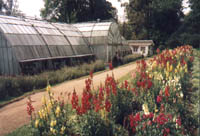
Lloyd Botanical Gardens
The Dhirdham temple
This Hindu temple was built in 1939 on the model of the Pashupatinath temple of Kathmandu in Nepal.
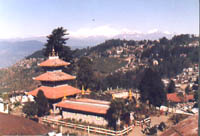
The Dhirdham temple
The Gompa Bhutia Busty
The gompas are Buddhist monasteries. The Bhuttia Busty was originally on Observatory Hill. It was rebuilt in the 19th century at the present place after being plundered by the Nepalese. In 1934 an earthquake destroyed it. It was rebuilt again thanks to the Raja of Sikkim. There are several other gompa in the area: the gompa Ghoom, the gompa Aloobari, the gompa Thupten Sangachoeling, etc.
The observatory hill
In addition to offering a beautiful view of the Kanchenjunga, Observatory Hill is a place of Hindu and Buddhist worship. There is a temple dedicated to Kali. You will also meet many monkeys who have chosen to live on the hill.
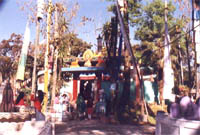
The observatory hill
Vishnupur
The city was founded by King Raghunath I of the Malla dynasty. It became the capital of the kingdom and developed between the eighth and eighteenth centuries. The reign of Virhambir in the sixteenth century is considered as the golden age of Vishnupur, notably thanks to its policy of development of the arts.
The area is devoid of stone quarry. The monuments were built in brick, which gives them a unique style and appearance. The town is also known for its pottery and saris.
The temple of Shyam Rai
This temple was built in 1643 by King Raghunath Singa. It is one of the finest examples of the "ratna" style with its 5 towers (pancharatna). The walls are richly decorated with panels representing scenes from the Mahabharata, the Ramayana and the life of Krishna.
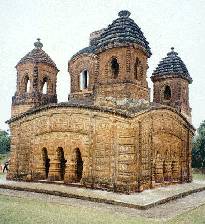
The temple of Shyam Rai
The temple of Jor Bangla
This temple was built by Raghunath Singha II in 1655. Its roof is typical of the "chala" style. The small tower reinforces the structure of the two curved twin roofs. The walls of the temple are very richly decorated.
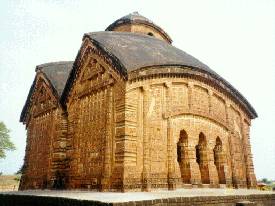
The temple of Jor Bangla
The Rasmancha
It is the oldest brick temple in the city, built in 1587 by King Virhambir. This temple houses the representations of Krishna and Radha. Its pyramidal structure is unique in Bengal.
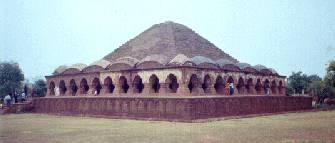
The Rasmancha
The temple of Madanmohan
It was built by King Durjana Singha Deva in 1649 in the style "ekratna". The walls are decorated with scenes from the Ramayana , the Mahabharata and the Purunas.
Kalimpong
The city, located on the foothills of the Himalayas, had a turbulent history like many cities in the region. It was once part of the territories of the Raja of Sikkim, then it was taken by the neighboring Bouthan in the eighteenth century before becoming British.
Located very north of the state of Bengal, the city attracts few travelers but it has many assets. It is a quiet place, base for many treks.
The Gompas
The Thongsa gompa, or Bhutanese monastery, was built in 1692. It is the oldest monastery in the area. The gompa Tharpa Choeling belongs to the Buddhist branch of the Gelugpa founded in the 14th century and to which the Dalai Lama belongs. The Gompa Zong Dog Palri Fo-Brang was built away from the city in the 70s. The gompa is admirable by the murals of the prayer hall and by the mandala of the first floor.
Nurseries
Kalimpong is an important floral production center. 80% of the Indian gladioli grow here as well as a large part of the orchids. Some nurseries have specialized in the cultivation of cacti. A big flower festival takes place in Kalimpong in October.
The Institution of Doctor Graham
This institution was built a few kilometers from Kalimpong in 1900. Its purpose was to educate the children of tea workers. It is now open to all but a quota of places is reserved for the poorest. The 1,300 students have an area of 193 hectares.
The chapel of the school built in 1925 has very beautiful stained-glass windows.
The research institution in sericulture
A visit to this institute will allow you to see how silkworms are high and how silk is produced.
Murshidabad
Murshidabad owes its name to Murshid Quli Khan, first independent nabob of Bengal between 1704 and 1725. His grandson Siraj ascended the throne in 1756, attacked the British forces of Calcutta and seized Fort William. But Siraj was defeated in 1757 during the Battle of Plassey. Siraj was assassinated at Murshidabad soon after by his uncle.
Murshidabad is watered by an important arm of the Ganges, the Bhagirathi. The city is known for its silk.
The Hazarduari
It is the main attraction of the city. Nicknamed the palace with a thousand doors, this building was built in 1837 by the English for the nabobs. It has 114 rooms and 18 galleries. You can see a beautiful chandelier offered by Queen Victoria. The Hazarduari is now a museum. You can see a beautiful collection of paintings, portraits of the nabobs, weapons, armor. The armory contains nearly 3,000 pieces including the swords of Siraj and his grandfather. On the third floor is a library, open on permission, containing 10792 books and 3791 old manuscripts (pandulipis).
The Katra Masjid
This mosque was erected in 1724 by the nabob Murshid Quli Khan on the model of the mosque of Mecca. The tomb of this nabob is found under the staircase of access. The mosque was severely damaged in 1897 by an earthquake.
The Bara Imambara
The largest imambara of Bengal was built by Siraj. It was destroyed by a fire in 1846 and rebuilt in 1848 by the nabob Nazir Mansur Ali. It is normally closed to the public except on rare occasions.
The gardens Khosbag, Roshnibag and Farahbag
Khosbag means "garden of happiness" in Persian. It is the place of burial of the nabobs and their families. You have to cross the river to get there. Roshnibag means "garden of light". A mosque was built there in the eighteenth century. Farahbag means "garden of pleasure".
The Sunderbans Reserve
In Bengali sunder means "beautiful" and bans "forests". The reserve was created within the Ganges delta and covers 2600 km2 of mangroves. It was declared a World Heritage Site by UNESCO in 1985. The region is made up of a hundred islands, but only about thirty are inhabited by fishermen and beekeepers (Sunderbans honey is very popular).
The fauna and flora are extraordinarily rich. It is here that we find the largest number of tigers (about 250) although it is very exceptional to see one. Nevertheless, every year there are several people killed by felines. The inhabitants of the Sunderbans have become accustomed to moving in the forest with a human face mask placed on the back of the skull because, it is said, the tiger never attacks the face.
At the seaside the aquatic species are evidently very numerous. You can see dolphins, sharks, crocodiles, snakes, turtles, etc. Further afield, there are monkeys, wild boars, deer, many birds, and so on. There is a heron reserve and a crocodile farm near Sajnekhali. The best way to visit the reserve is the boat you can rent for a day with a guide.
See also:


